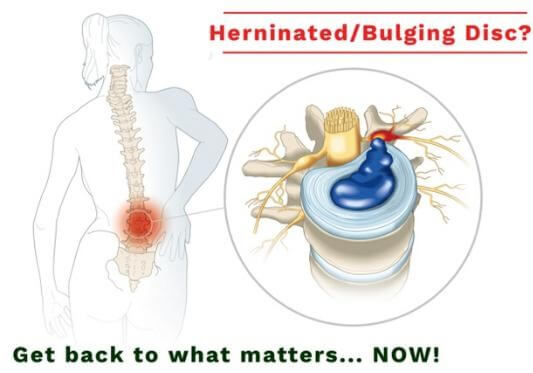
- The intervertebral disc acts as the shock absorber between the vertebra above and below. When they are hydrated and healthy, they keep the spine flexible. Think about the disc as a jelly filled doughnut with soft, squishy interior and tough, fibrous exterior. When the nucleus pulposus (jelly) begins to push on the annulus fibrosus (outer part of the doughnut), it can herniate/slip/protrude/bulge through some of those outer layers.
- When that occurs, the pressure inside the disc increases greatly. This can often cause significant, debilitating pain. Depending on the size of the herniation or bulge, the disc can encroach upon the nearby nerve root which would likely cause radiculopathy like symptoms such as sciatica (radiating pain). Some patients on the other hand can have a herniated or bulging disc but to a lesser degree.
- Diagnostic imaging might reveal a disc that is in the process of degenerating on its way to a herniation or rupture. While a patient might not feel any symptom at the current time, the spine is likely in a biomechanical distorted state causing undue forces which can lead to weakness, numbness, or tingling.
- Corrections to the spine via Upper Cervical Spinal Care often have a positive impact on herniated/bulging discs. Non-Surgical Spinal Decompression is the leading non-invasive treatment for herniated/bulging discs.
Testimonials
Dr Lea and all the staff at Crossroads Brain and Spine are great, hospitable, and pleasant to work with, they treat you with respect and honor and genuinely concerned with your well being.
I wanted to try to avoid traditional medical practices because of the risks involved with bad side effects(meds and medical procedures), I went to Dr Lea for help with my neck and the treatment he did for me, did help. I’m about 40-45% better than what I was, my pain levels were 9 to 10 on a scale of 1-10, and now my pain levels for my neck are not higher than seven, and my new normal seems to be between 4 to 6 with an average of 5, whenever I go for a treatment, it’s usually 1-3 the following day and sometimes the day after that(3rd day), but I’m older, and have done alot of hard work in my life(abused/overworked my body) so I can’t expect alot,
but Crossroads comes highly recommended…
Jeff
